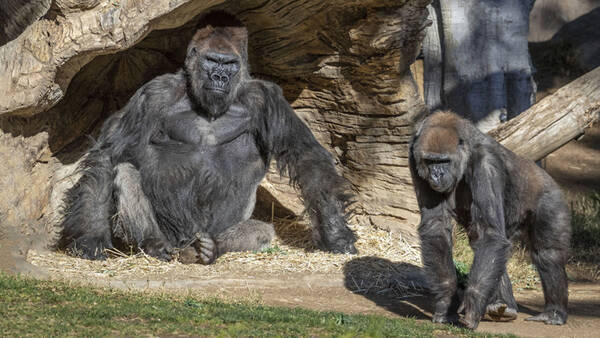Lowland GorillaWestern Gorilla
IUCN
LCBasic Information
Scientific classification
- name:Lowland GorillaWestern Gorilla
- Scientific Name:Gorilla gorilla,Lowland GorillaWestern Gorilla,Western gorilla, African western gorilla
- Outline:Primates
- Family:Hominidae Gorilla
Vital signs
- length:Height 150-180 cm
- Weight:70-140kg
- lifetime:About 40 years
Feature
Distribution and Habitat
Angola, Cameroon, Central African Republic, Congo, Equatorial Guinea, Gabon, Nigeria.
Regional extinction: Congo, Democratic Republic of Congo.
Appearance
The body is larger, the male is 180 cm tall, the female is 150 cm tall, the male weighs 140 kg, and the female weighs 70 kg. There are no hip calluses, the forelimbs can be as long as the knees, and the face is sparsely hairy. Males are larger than females, and their arms hang down to the ankles when standing; their arms and hands are thick and powerful, and their legs are short and not as strong as their arms; their thumbs (toes) can often be opposite to other fingers (toes), making them suitable for arboreal climbing and climbing. Hold something. The clavicle is well developed, the palms (and soles) are exposed, and have two rows of leather pads, which are helpful for climbing. Except for a few species with claws, most of the fingers (toes) have nails. The periorbital rim is bony, both eyes are squinted, the vision is developed, and the sense of smell is degraded.
Details
The scientific name of the West African gorilla is Gorilla gorilla, and its foreign name is Lowland GorillaWestern Gorilla. There are two subspecies, namely the West African lowland gorilla and the Cross River gorilla.

West African gorillas are active during the day and eat figs, rambutan, mangoes, honey, bird eggs, young birds, crustaceans, fresh vegetables and young plant shoots. They live in tropical rainforests, build nests with branches on branches 8 to 12 meters above the ground, cover them with leaves, and sleep on trees at night. They are usually docile, but very scary when angry. Use large leaves to cover the body on rainy days.
Listed in the World Conservation Union (IUCN) ver.: 2008 Endangered Species - Critically Endangered (CR).
Listed in the Endangered Species Appendix I of the Washington Convention on International Trade in Endangered Species CITES.
Protect wild animals and eliminate game.
Maintaining ecological balance is everyone's responsibility!








